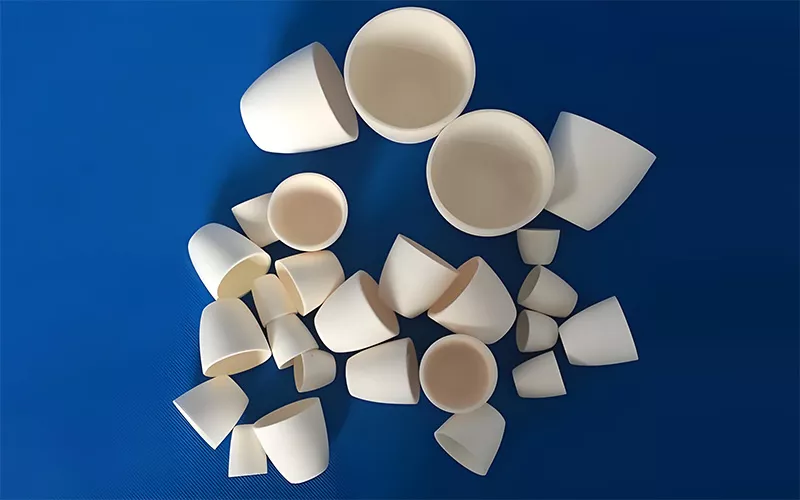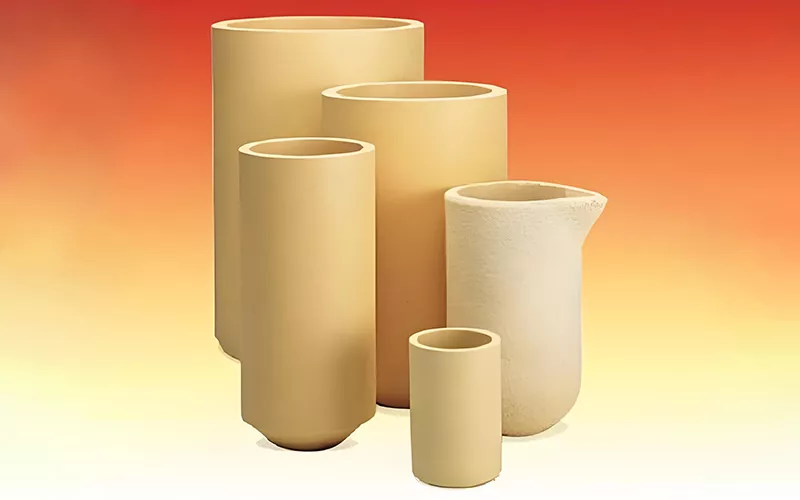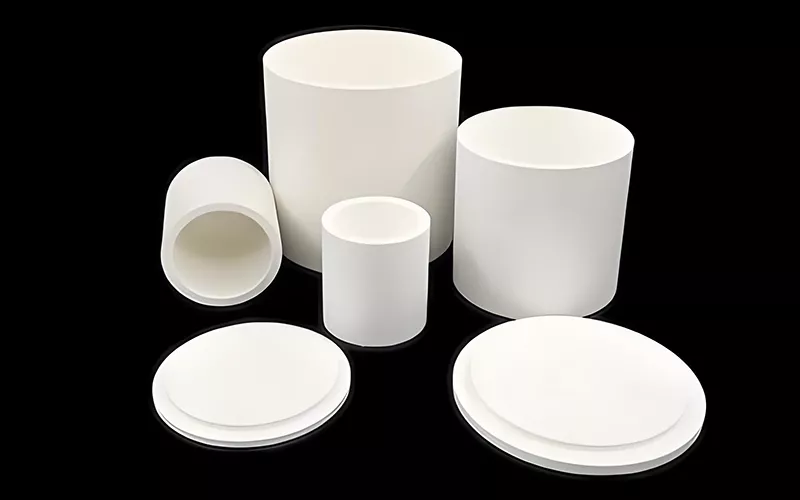Ceramic crucibles are containers with high melting points and high temperature resistance. They combine chemical stability with a low coefficient of thermal expansion, making them essential tools for extremely high-temperature applications in laboratories, metallurgy, semiconductor manufacturing, and other fields.
Ceramic crucibles are primarily made from advanced ceramics such as alumina, nitreto de boro, e óxido de zircônio. In this article, we’ll explore ceramic crucible material selection, key characteristics, and service life to help you select the most suitable crucible for your high-temperature application.

Quais são os materiais do cadinho de cerâmica?
Cadinho de Alumina
Cadinhos de cerâmica de alumina are primarily made of 99.7% pure aluminum oxide. Did you know? During the production process, many manufacturers, such as GORGEOUS, add small amounts of magnesium oxide (MgO) and silicon dioxide (SiO2) to impart superior physical and chemical properties to the crucibles.
Key Features: High-Temperature Resistance - Alumina crucibles can withstand temperatures of approximately 1700°C in a redox atmosphere. While offering superior performance, alumina crucibles are also price-competitive, making them the preferred material for many manufacturers.
Applications: Alumina crucibles are primarily used in laboratory and industrial metallurgy, heating, and chemical reactions.
Advantages: Alumina crucibles are one of the most economical ceramic crucibles on the market. Alumina’s high melting point and low thermal expansion coefficient make them resistant to cracking. They are ideal reaction vessels for weakly alkaline substances.
Limitations: Strongly corrosive substances, such as the strong base sodium hydroxide (NaOH), can severely damage alumina crucibles. For these materials, GORGEOUS recommends using a crucible material with strong corrosion resistance instead of alumina crucible.
Cadinho de zircônia
Zirconia crucibles are primarily made of high-purity zirconium oxide. Their exceptionally high temperature resistance and chemical stability make them ideal for extremely high-temperature melting processes.
Key Features: Zirconia crucibles boast robust high-temperature resistance, capable of withstanding temperatures up to 2000°C, making them ideal for melting precious metals such as platinum (Pt) and palladium (Pd).
Zirconium oxide also possesses excellent chemical resistance, maintaining a stable structure even in harsh environments with strong acids and alkalis, making it an ideal crucible material for processes prone to corrosion.
Applications: Zirconia crucibles are primarily used in precious metal melting and certain processes involving high-melting-point materials.
Cadinho de Alumina Temperada com Zircônia (Cadinho ZTA)
Zirconia-toughened alumina crucibles (ZTA) are primarily made of 90% alumina and 10% zirconia. This ceramic material combines the advantages of both alumina and zirconia, offering excellent high-temperature resistance and high toughness.
Principais características:
High Toughness - The addition of zirconia significantly improves the crucible’s crack and wear resistance, reducing damage caused by high temperatures and mechanical shock.
High-Temperature Resistance - ZTA crucibles can withstand temperatures up to 1700°C and operate stably in high-temperature environments.
Thermal Shock Resistance - Compared to pure alumina crucibles, ZTA crucibles offer higher thermal shock resistance, are more stable under severe temperature fluctuations, and are less prone to cracking.
Applications: These crucibles are primarily used in processes requiring high mechanical strength and high-temperature stability.
Cadinho de nitreto de boro (cadinho de PBN)
cadinhos de nitreto de boro are specially designed for use at extremely high temperatures. Their primary component is pyrolytic boron nitride.
Principais características:
High-Temperature Resistance - Boron nitride crucibles offer exceptional high-temperature resistance. In a protective atmosphere, they can reach temperatures of up to 2100°C and remain stable. They will not melt or react chemically with the substrate at extremely high temperatures.
Thermal Conductivity - Boron nitride crucibles have excellent thermal conductivity, allowing them to quickly dissipate heat, effectively preventing localized overheating, thermal stress, and thermal damage.
Low Thermal Expansion Coefficient - Boron nitride has a low thermal expansion coefficient, effectively reducing the risk of crucible cracking in high-temperature processes requiring rapid cooling or heating.
Applications: Boron nitride crucibles are primarily used in high-temperature processes such as semiconductor manufacturing and metal smelting. In the semiconductor industry, they are often used in chemical vapor deposition (CVD), crystal growth, and high-temperature evaporation.
Outros materiais cerâmicos
Além dos materiais cerâmicos comuns mencionados acima, também existem materiais de cadinho de alta qualidade, como óxido de magnésio e óxido de berílio. Todos eles apresentam excelente desempenho em altas temperaturas e são materiais essenciais para recipientes de cadinhos em muitas fundições de metais e laboratórios.
Como garantir a vida útil do cadinho?
If you want your crucible to have better performance and service life, you’d better do the following:
Armazenar:
É melhor armazenar cadinhos usados em um ambiente seco e limpo para evitar que absorvam umidade e contaminação. Evite armazená-los perto de produtos químicos ou em áreas com alta umidade.
Operar:
Você deve usar ferramentas apropriadas para operar o cadinho, evitar contato direto com as mãos e verificar se há rachaduras ou danos após o uso.
Limpeza:
Limpe bem o cadinho após cada uso. Remova todos os resíduos e deixe-o esfriar adequadamente antes da limpeza para evitar choque térmico e rachaduras.
Perguntas frequentes
1. O que é um cadinho?
Um cadinho é um recipiente projetado para uso em temperaturas extremamente altas, usado principalmente para fundição de metais e reações químicas.
2. Qual é o ponto de fusão de um cadinho de cerâmica?
O ponto de fusão de um cadinho de cerâmica depende principalmente do material utilizado. Por exemplo, um cadinho de alumina pode suportar temperaturas entre 1650 °C e 1700 °C, enquanto um cadinho de zircônia pode suportar temperaturas de até 2000 °C.
3. Quais são os usos dos cadinhos de cerâmica na química?
Cadinhos de cerâmica são frequentemente usados para fundição de metais em alta temperatura, como recipientes para reações químicas, recipientes para processamento de materiais, etc.
4. Qual é a função do cadinho de cerâmica?
O cadinho de cerâmica é usado principalmente para aplicações de aquecimento em alta temperatura, fusão ou refino de materiais, etc. Ele também pode atuar como um recipiente para algumas reações químicas.
5. Quais são as propriedades materiais dos cadinhos cerâmicos?
Os materiais cerâmicos têm as características de alto ponto de fusão, baixo coeficiente de expansão térmica, boa estabilidade térmica e resistência à corrosão química.
6. Cadinhos de cerâmica podem ser usados para derreter substâncias alcalinas fortes?
Isso depende principalmente do material do cadinho. Geralmente, não recomendamos o uso de cadinhos de alumina para fundir substâncias alcalinas fortes, como hidróxido de sódio (NaOH) e peróxido de sódio (Na₂O₂), pois essas substâncias podem corroer o cadinho.
7. Qual é a diferença entre cadinho de porcelana e cadinho de cerâmica?
Cadinho de porcelana geralmente se refere a um cadinho feito de porcelana. O cadinho de cerâmica tem desempenho superior ao cadinho de porcelana tradicional, pode suportar temperaturas mais altas e possui propriedades mecânicas mais robustas.
8. Como aquecer um cadinho de cerâmica?
Ao aquecer um cadinho cerâmico, deve-se escolher um método de aquecimento adequado às características do material do cadinho. Deve-se observar que resfriamentos ou aquecimentos bruscos devem ser evitados durante o aquecimento, pois podem causar rachaduras no cadinho.
9. Quais são os métodos de manutenção para cadinhos cerâmicos?
Após usar o cadinho, você deve limpá-lo completamente para remover os resíduos, usar uma solução de limpeza apropriada para limpá-lo e, por fim, enxaguá-lo com água pura e secá-lo para uso posterior.
Conclusão
Ceramic crucibles are indispensable tools in modern chemistry and metallurgy. Capable of operating in extreme temperatures and harsh chemical environments, they play a key role in a wide range of scientific and industrial applications. GORGEOUS, a leading international supplier of advanced ceramics, offers custom-made ceramic crucibles in a variety of materials. Thank you for reading this article, and we hope you find it helpful.